Business Law Report: Employment, Equality and EU Law in the UK Context
VerifiedAdded on 2020/01/07
|10
|3464
|229
Report
AI Summary
This report provides a comprehensive overview of key aspects of UK business law, focusing on the Employment Rights Act 1996 and the Equality Act 2010. The report begins by examining the sources of employment contract terms, including express and implied terms, and then details the common law duties of both employees and employers. It delves into the Equality Act 2010, outlining its scope, structure, and the different types of discrimination it covers, such as direct, indirect, and harassment. The report further discusses the actions employers should take to comply with the Equality Act. Finally, it touches upon the main sources of European Union (EU) law relevant to employment, specifically Directive 92/85/EC and Directive 2000/78/EC. The report aims to provide a clear understanding of the legal framework governing employment relationships and equality in the UK, highlighting the rights and responsibilities of both employers and employees.
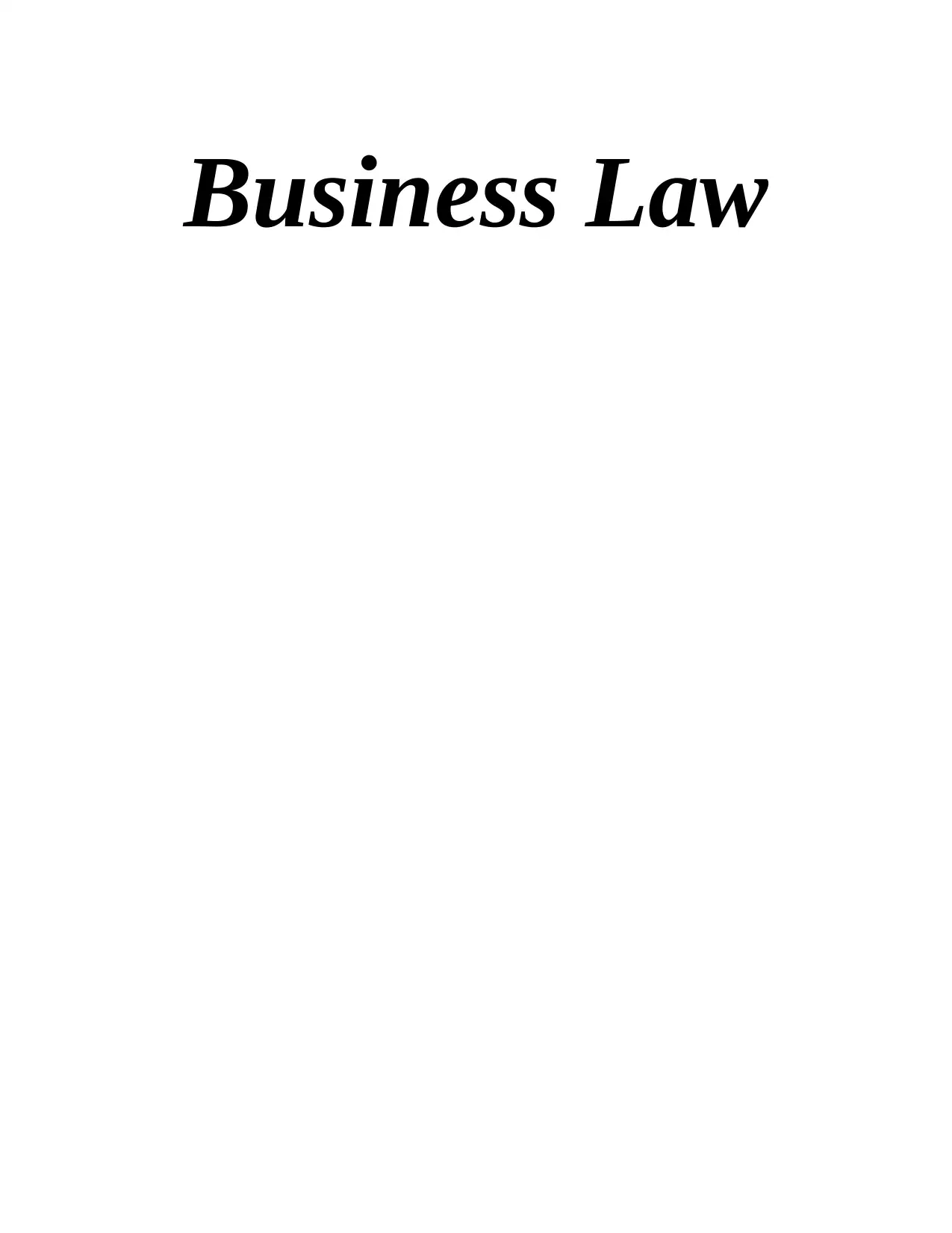
Business Law
Paraphrase This Document
Need a fresh take? Get an instant paraphrase of this document with our AI Paraphraser
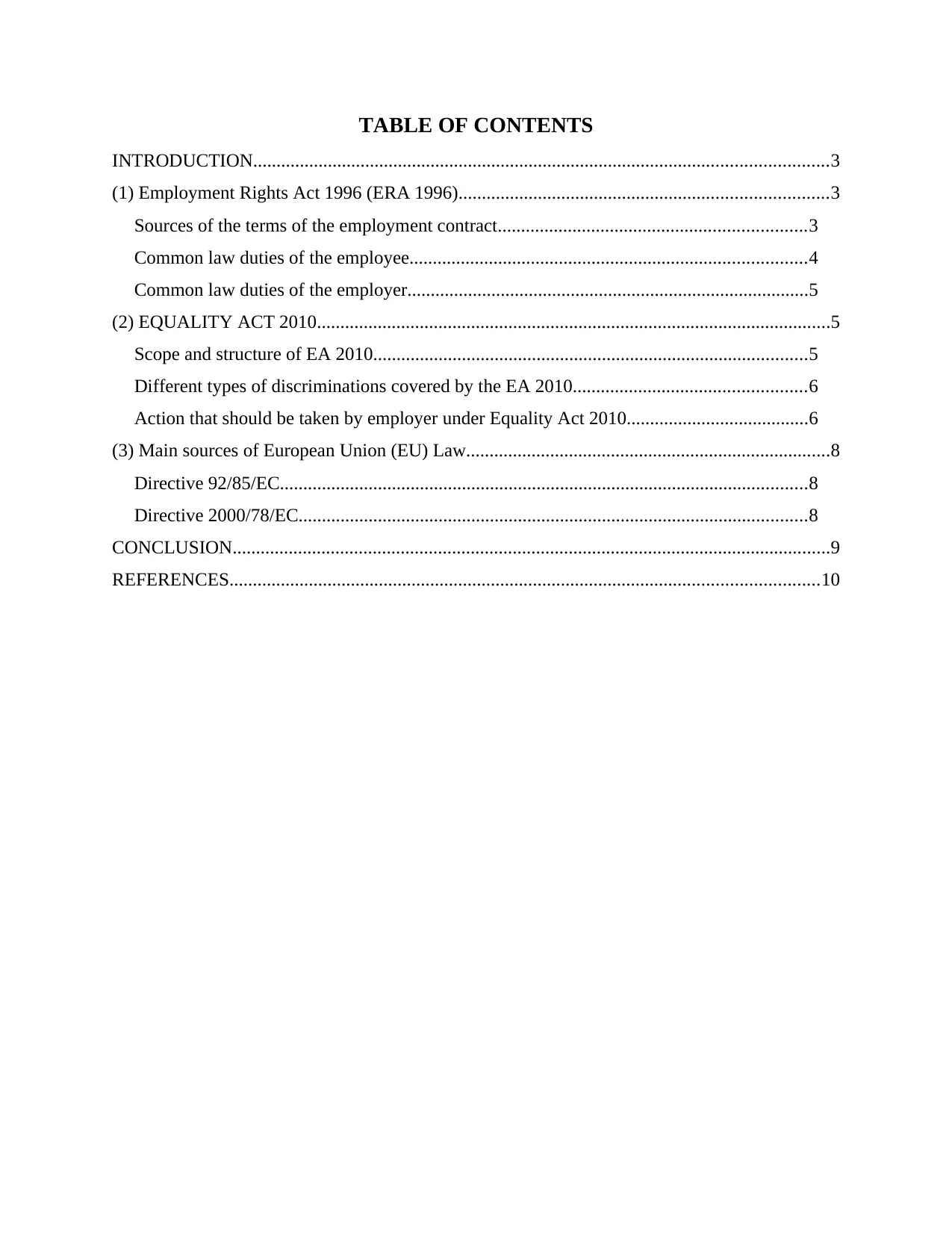
TABLE OF CONTENTS
INTRODUCTION...........................................................................................................................3
(1) Employment Rights Act 1996 (ERA 1996)...............................................................................3
Sources of the terms of the employment contract..................................................................3
Common law duties of the employee.....................................................................................4
Common law duties of the employer......................................................................................5
(2) EQUALITY ACT 2010..............................................................................................................5
Scope and structure of EA 2010.............................................................................................5
Different types of discriminations covered by the EA 2010..................................................6
Action that should be taken by employer under Equality Act 2010.......................................6
(3) Main sources of European Union (EU) Law..............................................................................8
Directive 92/85/EC.................................................................................................................8
Directive 2000/78/EC.............................................................................................................8
CONCLUSION................................................................................................................................9
REFERENCES..............................................................................................................................10
INTRODUCTION...........................................................................................................................3
(1) Employment Rights Act 1996 (ERA 1996)...............................................................................3
Sources of the terms of the employment contract..................................................................3
Common law duties of the employee.....................................................................................4
Common law duties of the employer......................................................................................5
(2) EQUALITY ACT 2010..............................................................................................................5
Scope and structure of EA 2010.............................................................................................5
Different types of discriminations covered by the EA 2010..................................................6
Action that should be taken by employer under Equality Act 2010.......................................6
(3) Main sources of European Union (EU) Law..............................................................................8
Directive 92/85/EC.................................................................................................................8
Directive 2000/78/EC.............................................................................................................8
CONCLUSION................................................................................................................................9
REFERENCES..............................................................................................................................10
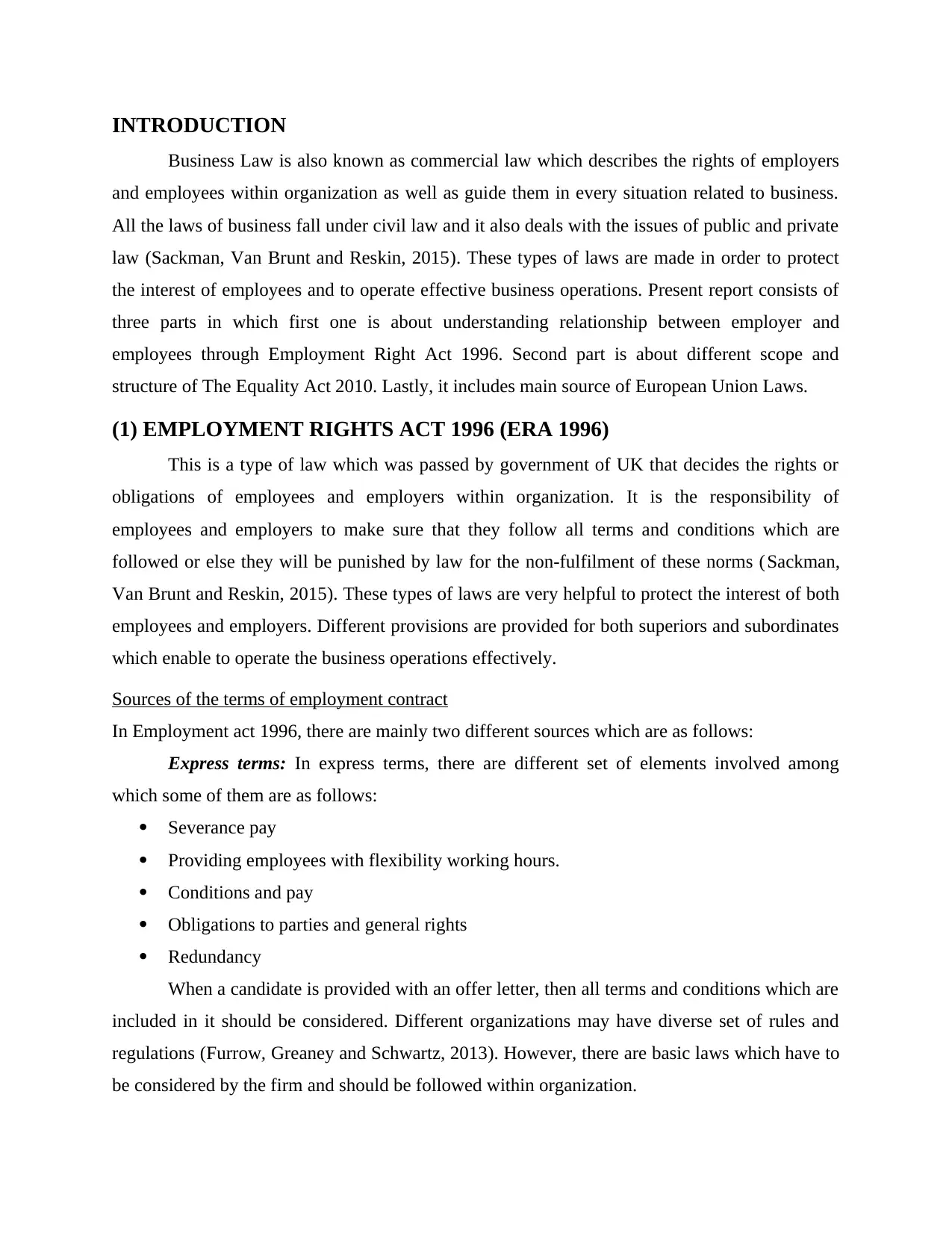
INTRODUCTION
Business Law is also known as commercial law which describes the rights of employers
and employees within organization as well as guide them in every situation related to business.
All the laws of business fall under civil law and it also deals with the issues of public and private
law (Sackman, Van Brunt and Reskin, 2015). These types of laws are made in order to protect
the interest of employees and to operate effective business operations. Present report consists of
three parts in which first one is about understanding relationship between employer and
employees through Employment Right Act 1996. Second part is about different scope and
structure of The Equality Act 2010. Lastly, it includes main source of European Union Laws.
(1) EMPLOYMENT RIGHTS ACT 1996 (ERA 1996)
This is a type of law which was passed by government of UK that decides the rights or
obligations of employees and employers within organization. It is the responsibility of
employees and employers to make sure that they follow all terms and conditions which are
followed or else they will be punished by law for the non-fulfilment of these norms (Sackman,
Van Brunt and Reskin, 2015). These types of laws are very helpful to protect the interest of both
employees and employers. Different provisions are provided for both superiors and subordinates
which enable to operate the business operations effectively.
Sources of the terms of employment contract
In Employment act 1996, there are mainly two different sources which are as follows:
Express terms: In express terms, there are different set of elements involved among
which some of them are as follows:
Severance pay
Providing employees with flexibility working hours.
Conditions and pay
Obligations to parties and general rights
Redundancy
When a candidate is provided with an offer letter, then all terms and conditions which are
included in it should be considered. Different organizations may have diverse set of rules and
regulations (Furrow, Greaney and Schwartz, 2013). However, there are basic laws which have to
be considered by the firm and should be followed within organization.
Business Law is also known as commercial law which describes the rights of employers
and employees within organization as well as guide them in every situation related to business.
All the laws of business fall under civil law and it also deals with the issues of public and private
law (Sackman, Van Brunt and Reskin, 2015). These types of laws are made in order to protect
the interest of employees and to operate effective business operations. Present report consists of
three parts in which first one is about understanding relationship between employer and
employees through Employment Right Act 1996. Second part is about different scope and
structure of The Equality Act 2010. Lastly, it includes main source of European Union Laws.
(1) EMPLOYMENT RIGHTS ACT 1996 (ERA 1996)
This is a type of law which was passed by government of UK that decides the rights or
obligations of employees and employers within organization. It is the responsibility of
employees and employers to make sure that they follow all terms and conditions which are
followed or else they will be punished by law for the non-fulfilment of these norms (Sackman,
Van Brunt and Reskin, 2015). These types of laws are very helpful to protect the interest of both
employees and employers. Different provisions are provided for both superiors and subordinates
which enable to operate the business operations effectively.
Sources of the terms of employment contract
In Employment act 1996, there are mainly two different sources which are as follows:
Express terms: In express terms, there are different set of elements involved among
which some of them are as follows:
Severance pay
Providing employees with flexibility working hours.
Conditions and pay
Obligations to parties and general rights
Redundancy
When a candidate is provided with an offer letter, then all terms and conditions which are
included in it should be considered. Different organizations may have diverse set of rules and
regulations (Furrow, Greaney and Schwartz, 2013). However, there are basic laws which have to
be considered by the firm and should be followed within organization.
⊘ This is a preview!⊘
Do you want full access?
Subscribe today to unlock all pages.

Trusted by 1+ million students worldwide
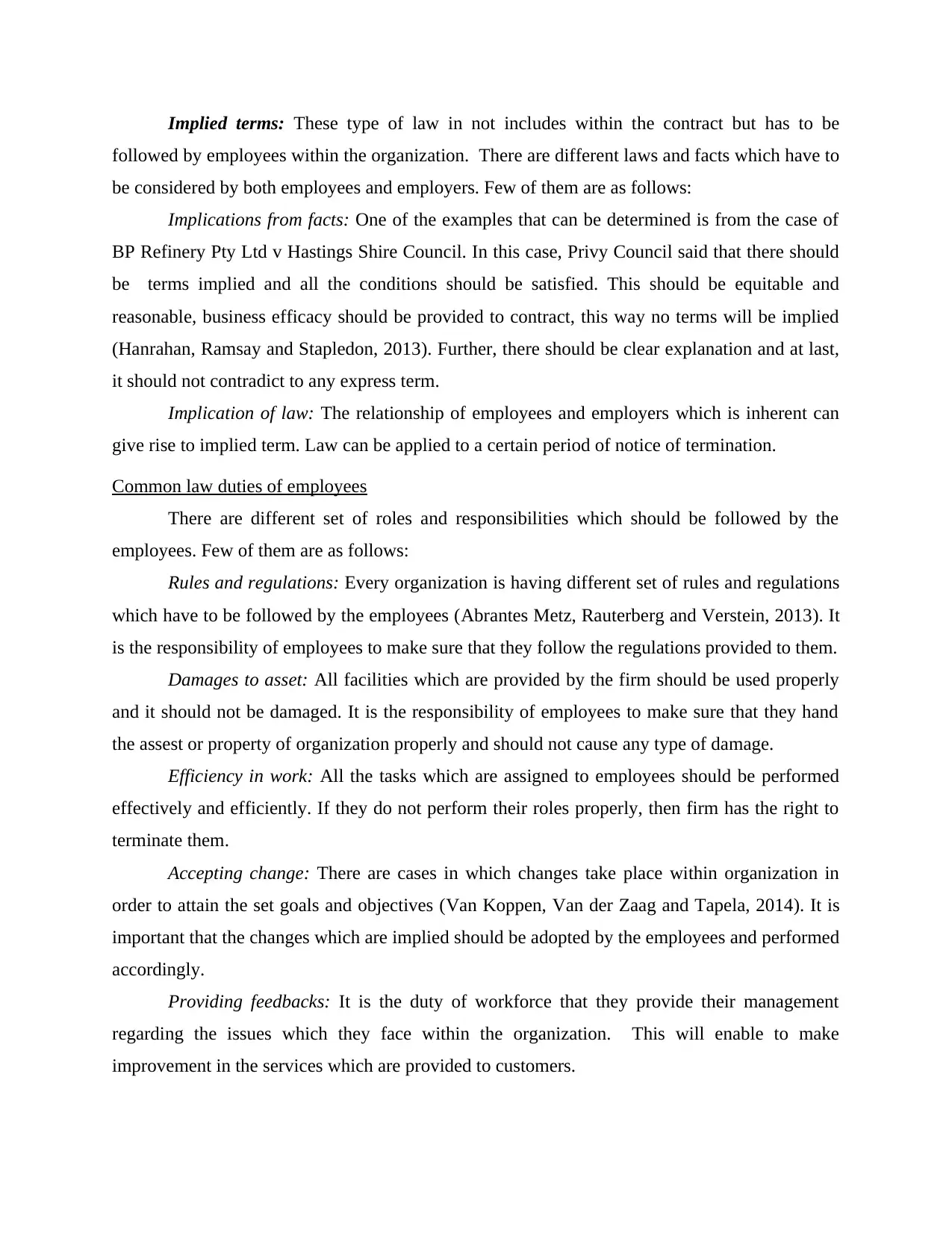
Implied terms: These type of law in not includes within the contract but has to be
followed by employees within the organization. There are different laws and facts which have to
be considered by both employees and employers. Few of them are as follows:
Implications from facts: One of the examples that can be determined is from the case of
BP Refinery Pty Ltd v Hastings Shire Council. In this case, Privy Council said that there should
be terms implied and all the conditions should be satisfied. This should be equitable and
reasonable, business efficacy should be provided to contract, this way no terms will be implied
(Hanrahan, Ramsay and Stapledon, 2013). Further, there should be clear explanation and at last,
it should not contradict to any express term.
Implication of law: The relationship of employees and employers which is inherent can
give rise to implied term. Law can be applied to a certain period of notice of termination.
Common law duties of employees
There are different set of roles and responsibilities which should be followed by the
employees. Few of them are as follows:
Rules and regulations: Every organization is having different set of rules and regulations
which have to be followed by the employees (Abrantes Metz, Rauterberg and Verstein, 2013). It
is the responsibility of employees to make sure that they follow the regulations provided to them.
Damages to asset: All facilities which are provided by the firm should be used properly
and it should not be damaged. It is the responsibility of employees to make sure that they hand
the assest or property of organization properly and should not cause any type of damage.
Efficiency in work: All the tasks which are assigned to employees should be performed
effectively and efficiently. If they do not perform their roles properly, then firm has the right to
terminate them.
Accepting change: There are cases in which changes take place within organization in
order to attain the set goals and objectives (Van Koppen, Van der Zaag and Tapela, 2014). It is
important that the changes which are implied should be adopted by the employees and performed
accordingly.
Providing feedbacks: It is the duty of workforce that they provide their management
regarding the issues which they face within the organization. This will enable to make
improvement in the services which are provided to customers.
followed by employees within the organization. There are different laws and facts which have to
be considered by both employees and employers. Few of them are as follows:
Implications from facts: One of the examples that can be determined is from the case of
BP Refinery Pty Ltd v Hastings Shire Council. In this case, Privy Council said that there should
be terms implied and all the conditions should be satisfied. This should be equitable and
reasonable, business efficacy should be provided to contract, this way no terms will be implied
(Hanrahan, Ramsay and Stapledon, 2013). Further, there should be clear explanation and at last,
it should not contradict to any express term.
Implication of law: The relationship of employees and employers which is inherent can
give rise to implied term. Law can be applied to a certain period of notice of termination.
Common law duties of employees
There are different set of roles and responsibilities which should be followed by the
employees. Few of them are as follows:
Rules and regulations: Every organization is having different set of rules and regulations
which have to be followed by the employees (Abrantes Metz, Rauterberg and Verstein, 2013). It
is the responsibility of employees to make sure that they follow the regulations provided to them.
Damages to asset: All facilities which are provided by the firm should be used properly
and it should not be damaged. It is the responsibility of employees to make sure that they hand
the assest or property of organization properly and should not cause any type of damage.
Efficiency in work: All the tasks which are assigned to employees should be performed
effectively and efficiently. If they do not perform their roles properly, then firm has the right to
terminate them.
Accepting change: There are cases in which changes take place within organization in
order to attain the set goals and objectives (Van Koppen, Van der Zaag and Tapela, 2014). It is
important that the changes which are implied should be adopted by the employees and performed
accordingly.
Providing feedbacks: It is the duty of workforce that they provide their management
regarding the issues which they face within the organization. This will enable to make
improvement in the services which are provided to customers.
Paraphrase This Document
Need a fresh take? Get an instant paraphrase of this document with our AI Paraphraser
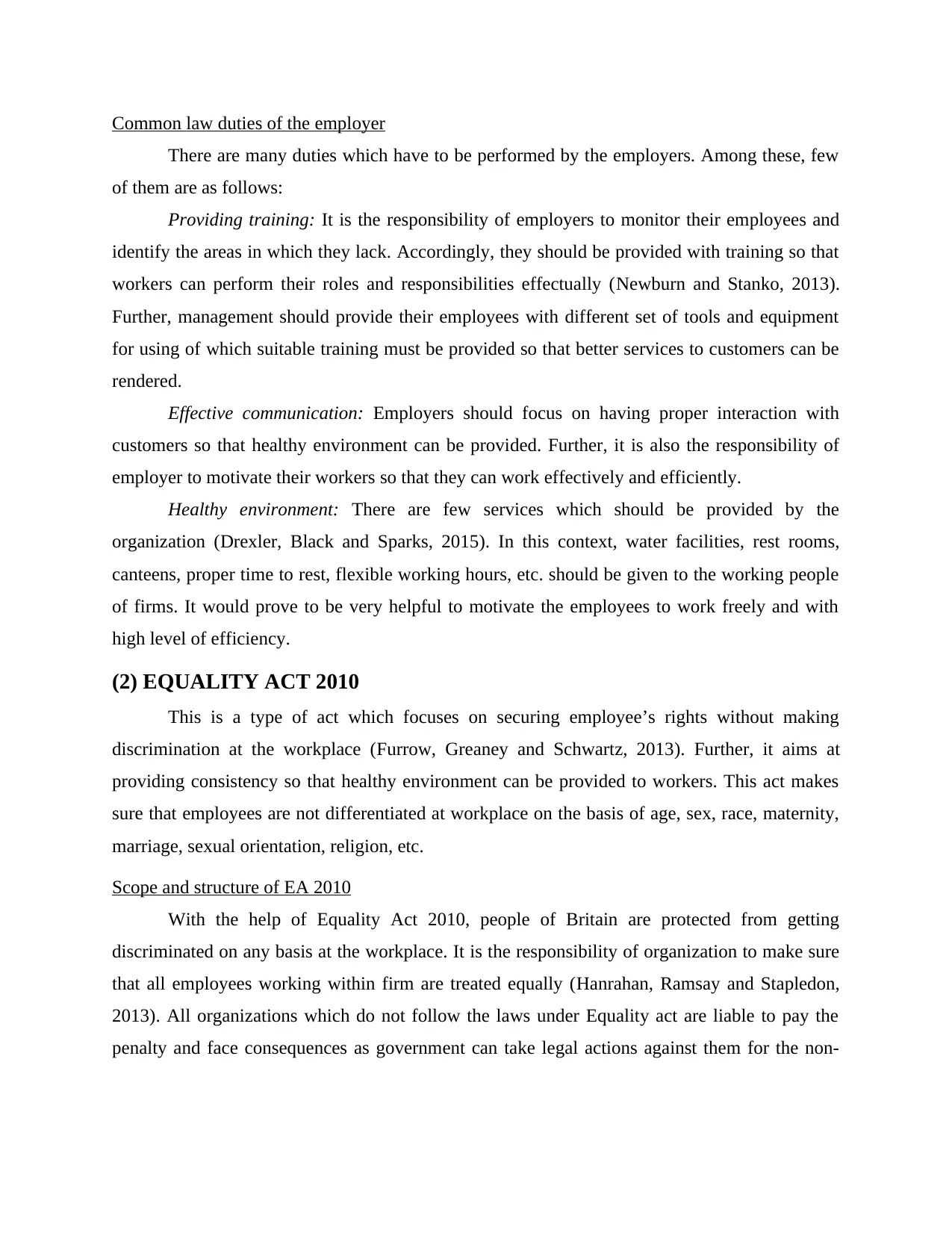
Common law duties of the employer
There are many duties which have to be performed by the employers. Among these, few
of them are as follows:
Providing training: It is the responsibility of employers to monitor their employees and
identify the areas in which they lack. Accordingly, they should be provided with training so that
workers can perform their roles and responsibilities effectually (Newburn and Stanko, 2013).
Further, management should provide their employees with different set of tools and equipment
for using of which suitable training must be provided so that better services to customers can be
rendered.
Effective communication: Employers should focus on having proper interaction with
customers so that healthy environment can be provided. Further, it is also the responsibility of
employer to motivate their workers so that they can work effectively and efficiently.
Healthy environment: There are few services which should be provided by the
organization (Drexler, Black and Sparks, 2015). In this context, water facilities, rest rooms,
canteens, proper time to rest, flexible working hours, etc. should be given to the working people
of firms. It would prove to be very helpful to motivate the employees to work freely and with
high level of efficiency.
(2) EQUALITY ACT 2010
This is a type of act which focuses on securing employee’s rights without making
discrimination at the workplace (Furrow, Greaney and Schwartz, 2013). Further, it aims at
providing consistency so that healthy environment can be provided to workers. This act makes
sure that employees are not differentiated at workplace on the basis of age, sex, race, maternity,
marriage, sexual orientation, religion, etc.
Scope and structure of EA 2010
With the help of Equality Act 2010, people of Britain are protected from getting
discriminated on any basis at the workplace. It is the responsibility of organization to make sure
that all employees working within firm are treated equally (Hanrahan, Ramsay and Stapledon,
2013). All organizations which do not follow the laws under Equality act are liable to pay the
penalty and face consequences as government can take legal actions against them for the non-
There are many duties which have to be performed by the employers. Among these, few
of them are as follows:
Providing training: It is the responsibility of employers to monitor their employees and
identify the areas in which they lack. Accordingly, they should be provided with training so that
workers can perform their roles and responsibilities effectually (Newburn and Stanko, 2013).
Further, management should provide their employees with different set of tools and equipment
for using of which suitable training must be provided so that better services to customers can be
rendered.
Effective communication: Employers should focus on having proper interaction with
customers so that healthy environment can be provided. Further, it is also the responsibility of
employer to motivate their workers so that they can work effectively and efficiently.
Healthy environment: There are few services which should be provided by the
organization (Drexler, Black and Sparks, 2015). In this context, water facilities, rest rooms,
canteens, proper time to rest, flexible working hours, etc. should be given to the working people
of firms. It would prove to be very helpful to motivate the employees to work freely and with
high level of efficiency.
(2) EQUALITY ACT 2010
This is a type of act which focuses on securing employee’s rights without making
discrimination at the workplace (Furrow, Greaney and Schwartz, 2013). Further, it aims at
providing consistency so that healthy environment can be provided to workers. This act makes
sure that employees are not differentiated at workplace on the basis of age, sex, race, maternity,
marriage, sexual orientation, religion, etc.
Scope and structure of EA 2010
With the help of Equality Act 2010, people of Britain are protected from getting
discriminated on any basis at the workplace. It is the responsibility of organization to make sure
that all employees working within firm are treated equally (Hanrahan, Ramsay and Stapledon,
2013). All organizations which do not follow the laws under Equality act are liable to pay the
penalty and face consequences as government can take legal actions against them for the non-
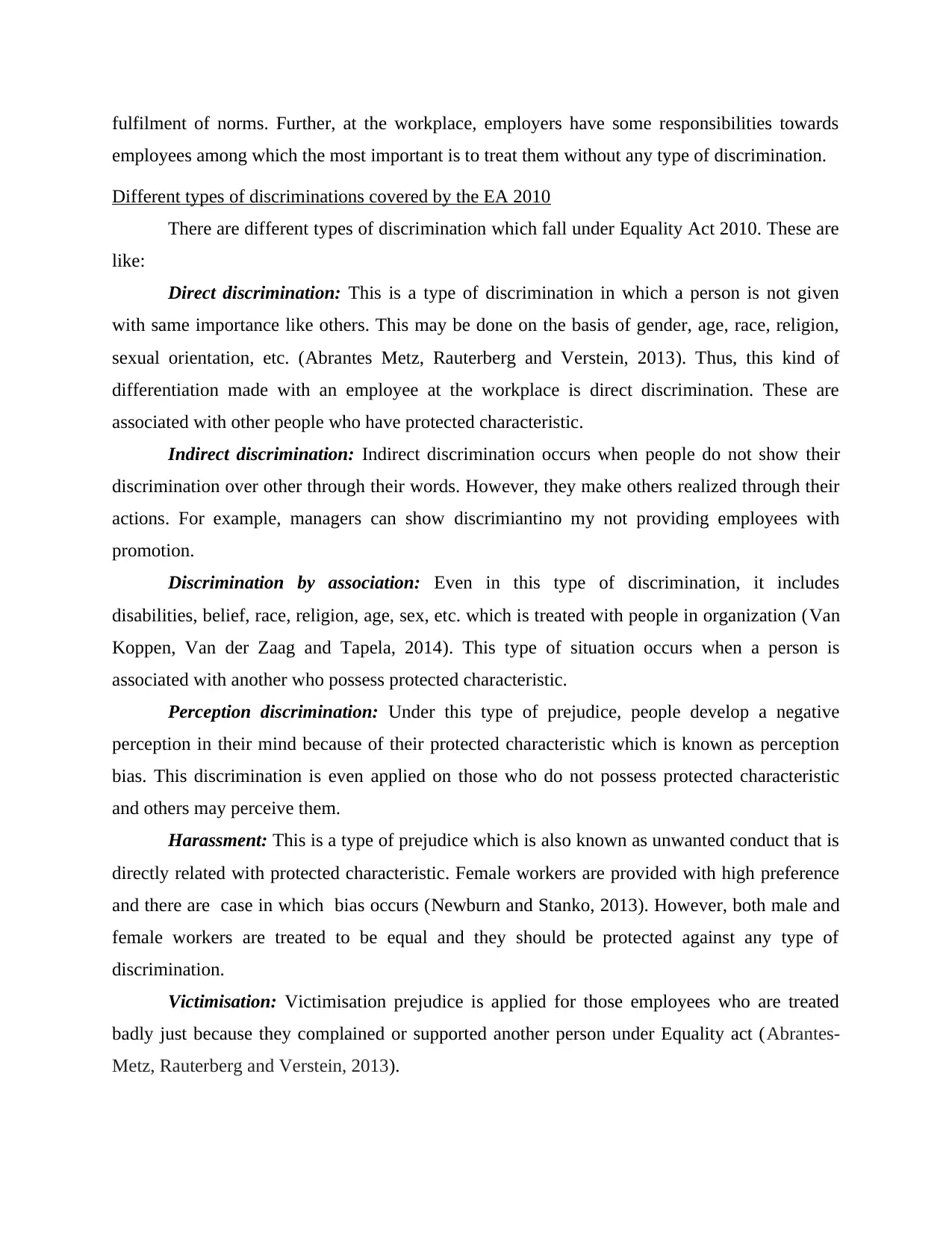
fulfilment of norms. Further, at the workplace, employers have some responsibilities towards
employees among which the most important is to treat them without any type of discrimination.
Different types of discriminations covered by the EA 2010
There are different types of discrimination which fall under Equality Act 2010. These are
like:
Direct discrimination: This is a type of discrimination in which a person is not given
with same importance like others. This may be done on the basis of gender, age, race, religion,
sexual orientation, etc. (Abrantes Metz, Rauterberg and Verstein, 2013). Thus, this kind of
differentiation made with an employee at the workplace is direct discrimination. These are
associated with other people who have protected characteristic.
Indirect discrimination: Indirect discrimination occurs when people do not show their
discrimination over other through their words. However, they make others realized through their
actions. For example, managers can show discrimiantino my not providing employees with
promotion.
Discrimination by association: Even in this type of discrimination, it includes
disabilities, belief, race, religion, age, sex, etc. which is treated with people in organization (Van
Koppen, Van der Zaag and Tapela, 2014). This type of situation occurs when a person is
associated with another who possess protected characteristic.
Perception discrimination: Under this type of prejudice, people develop a negative
perception in their mind because of their protected characteristic which is known as perception
bias. This discrimination is even applied on those who do not possess protected characteristic
and others may perceive them.
Harassment: This is a type of prejudice which is also known as unwanted conduct that is
directly related with protected characteristic. Female workers are provided with high preference
and there are case in which bias occurs (Newburn and Stanko, 2013). However, both male and
female workers are treated to be equal and they should be protected against any type of
discrimination.
Victimisation: Victimisation prejudice is applied for those employees who are treated
badly just because they complained or supported another person under Equality act (Abrantes-
Metz, Rauterberg and Verstein, 2013).
employees among which the most important is to treat them without any type of discrimination.
Different types of discriminations covered by the EA 2010
There are different types of discrimination which fall under Equality Act 2010. These are
like:
Direct discrimination: This is a type of discrimination in which a person is not given
with same importance like others. This may be done on the basis of gender, age, race, religion,
sexual orientation, etc. (Abrantes Metz, Rauterberg and Verstein, 2013). Thus, this kind of
differentiation made with an employee at the workplace is direct discrimination. These are
associated with other people who have protected characteristic.
Indirect discrimination: Indirect discrimination occurs when people do not show their
discrimination over other through their words. However, they make others realized through their
actions. For example, managers can show discrimiantino my not providing employees with
promotion.
Discrimination by association: Even in this type of discrimination, it includes
disabilities, belief, race, religion, age, sex, etc. which is treated with people in organization (Van
Koppen, Van der Zaag and Tapela, 2014). This type of situation occurs when a person is
associated with another who possess protected characteristic.
Perception discrimination: Under this type of prejudice, people develop a negative
perception in their mind because of their protected characteristic which is known as perception
bias. This discrimination is even applied on those who do not possess protected characteristic
and others may perceive them.
Harassment: This is a type of prejudice which is also known as unwanted conduct that is
directly related with protected characteristic. Female workers are provided with high preference
and there are case in which bias occurs (Newburn and Stanko, 2013). However, both male and
female workers are treated to be equal and they should be protected against any type of
discrimination.
Victimisation: Victimisation prejudice is applied for those employees who are treated
badly just because they complained or supported another person under Equality act (Abrantes-
Metz, Rauterberg and Verstein, 2013).
⊘ This is a preview!⊘
Do you want full access?
Subscribe today to unlock all pages.

Trusted by 1+ million students worldwide
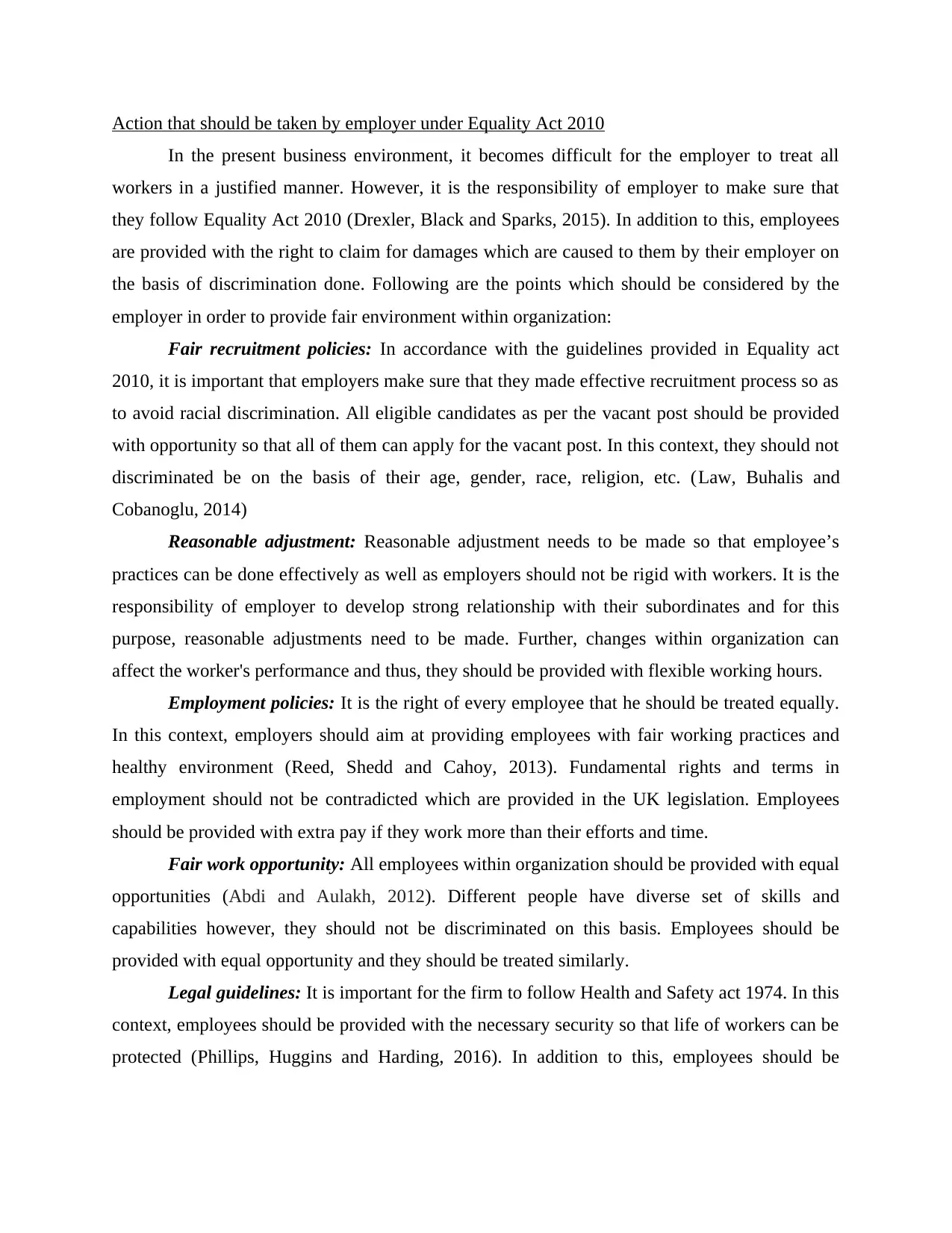
Action that should be taken by employer under Equality Act 2010
In the present business environment, it becomes difficult for the employer to treat all
workers in a justified manner. However, it is the responsibility of employer to make sure that
they follow Equality Act 2010 (Drexler, Black and Sparks, 2015). In addition to this, employees
are provided with the right to claim for damages which are caused to them by their employer on
the basis of discrimination done. Following are the points which should be considered by the
employer in order to provide fair environment within organization:
Fair recruitment policies: In accordance with the guidelines provided in Equality act
2010, it is important that employers make sure that they made effective recruitment process so as
to avoid racial discrimination. All eligible candidates as per the vacant post should be provided
with opportunity so that all of them can apply for the vacant post. In this context, they should not
discriminated be on the basis of their age, gender, race, religion, etc. (Law, Buhalis and
Cobanoglu, 2014)
Reasonable adjustment: Reasonable adjustment needs to be made so that employee’s
practices can be done effectively as well as employers should not be rigid with workers. It is the
responsibility of employer to develop strong relationship with their subordinates and for this
purpose, reasonable adjustments need to be made. Further, changes within organization can
affect the worker's performance and thus, they should be provided with flexible working hours.
Employment policies: It is the right of every employee that he should be treated equally.
In this context, employers should aim at providing employees with fair working practices and
healthy environment (Reed, Shedd and Cahoy, 2013). Fundamental rights and terms in
employment should not be contradicted which are provided in the UK legislation. Employees
should be provided with extra pay if they work more than their efforts and time.
Fair work opportunity: All employees within organization should be provided with equal
opportunities (Abdi and Aulakh, 2012). Different people have diverse set of skills and
capabilities however, they should not be discriminated on this basis. Employees should be
provided with equal opportunity and they should be treated similarly.
Legal guidelines: It is important for the firm to follow Health and Safety act 1974. In this
context, employees should be provided with the necessary security so that life of workers can be
protected (Phillips, Huggins and Harding, 2016). In addition to this, employees should be
In the present business environment, it becomes difficult for the employer to treat all
workers in a justified manner. However, it is the responsibility of employer to make sure that
they follow Equality Act 2010 (Drexler, Black and Sparks, 2015). In addition to this, employees
are provided with the right to claim for damages which are caused to them by their employer on
the basis of discrimination done. Following are the points which should be considered by the
employer in order to provide fair environment within organization:
Fair recruitment policies: In accordance with the guidelines provided in Equality act
2010, it is important that employers make sure that they made effective recruitment process so as
to avoid racial discrimination. All eligible candidates as per the vacant post should be provided
with opportunity so that all of them can apply for the vacant post. In this context, they should not
discriminated be on the basis of their age, gender, race, religion, etc. (Law, Buhalis and
Cobanoglu, 2014)
Reasonable adjustment: Reasonable adjustment needs to be made so that employee’s
practices can be done effectively as well as employers should not be rigid with workers. It is the
responsibility of employer to develop strong relationship with their subordinates and for this
purpose, reasonable adjustments need to be made. Further, changes within organization can
affect the worker's performance and thus, they should be provided with flexible working hours.
Employment policies: It is the right of every employee that he should be treated equally.
In this context, employers should aim at providing employees with fair working practices and
healthy environment (Reed, Shedd and Cahoy, 2013). Fundamental rights and terms in
employment should not be contradicted which are provided in the UK legislation. Employees
should be provided with extra pay if they work more than their efforts and time.
Fair work opportunity: All employees within organization should be provided with equal
opportunities (Abdi and Aulakh, 2012). Different people have diverse set of skills and
capabilities however, they should not be discriminated on this basis. Employees should be
provided with equal opportunity and they should be treated similarly.
Legal guidelines: It is important for the firm to follow Health and Safety act 1974. In this
context, employees should be provided with the necessary security so that life of workers can be
protected (Phillips, Huggins and Harding, 2016). In addition to this, employees should be
Paraphrase This Document
Need a fresh take? Get an instant paraphrase of this document with our AI Paraphraser
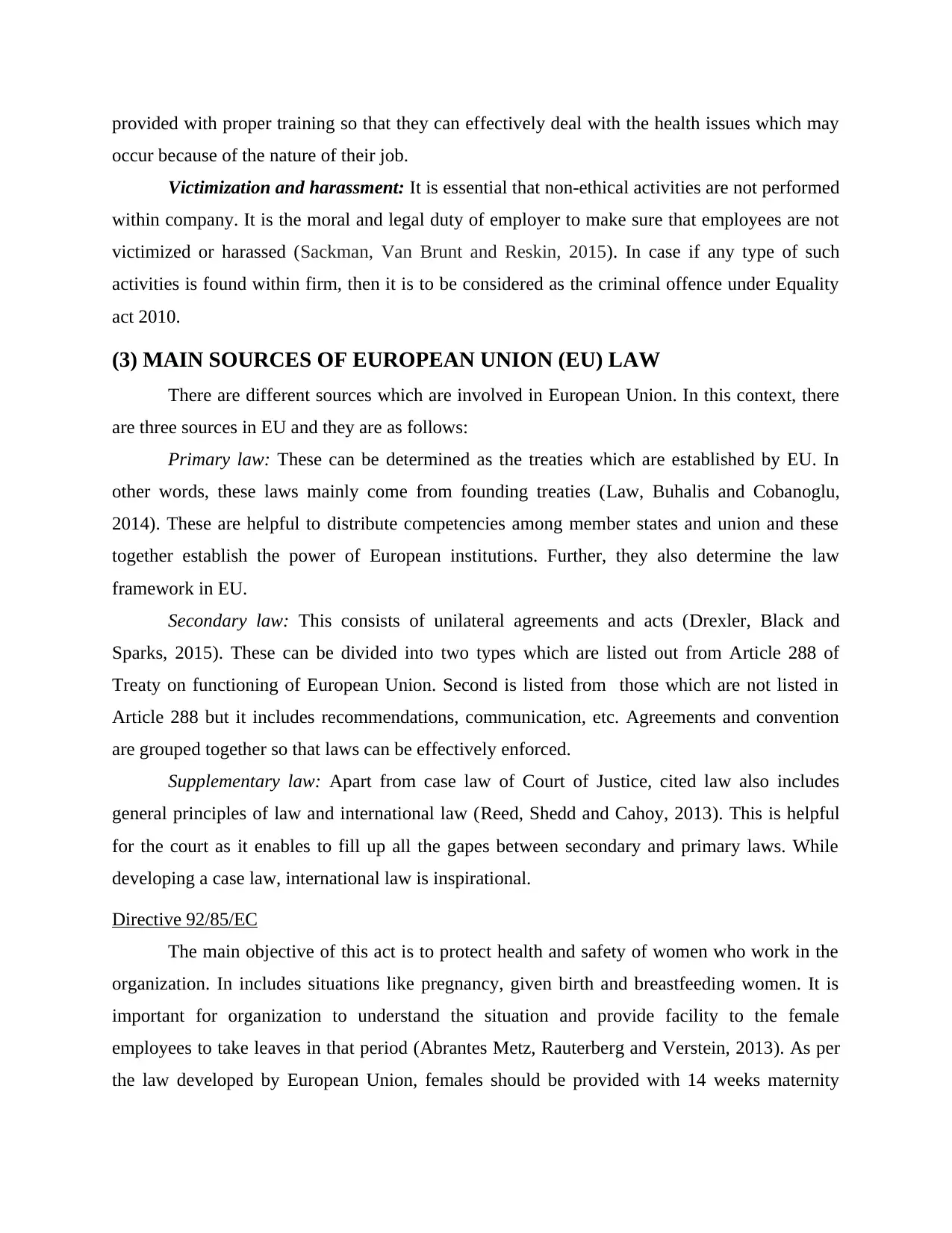
provided with proper training so that they can effectively deal with the health issues which may
occur because of the nature of their job.
Victimization and harassment: It is essential that non-ethical activities are not performed
within company. It is the moral and legal duty of employer to make sure that employees are not
victimized or harassed (Sackman, Van Brunt and Reskin, 2015). In case if any type of such
activities is found within firm, then it is to be considered as the criminal offence under Equality
act 2010.
(3) MAIN SOURCES OF EUROPEAN UNION (EU) LAW
There are different sources which are involved in European Union. In this context, there
are three sources in EU and they are as follows:
Primary law: These can be determined as the treaties which are established by EU. In
other words, these laws mainly come from founding treaties (Law, Buhalis and Cobanoglu,
2014). These are helpful to distribute competencies among member states and union and these
together establish the power of European institutions. Further, they also determine the law
framework in EU.
Secondary law: This consists of unilateral agreements and acts (Drexler, Black and
Sparks, 2015). These can be divided into two types which are listed out from Article 288 of
Treaty on functioning of European Union. Second is listed from those which are not listed in
Article 288 but it includes recommendations, communication, etc. Agreements and convention
are grouped together so that laws can be effectively enforced.
Supplementary law: Apart from case law of Court of Justice, cited law also includes
general principles of law and international law (Reed, Shedd and Cahoy, 2013). This is helpful
for the court as it enables to fill up all the gapes between secondary and primary laws. While
developing a case law, international law is inspirational.
Directive 92/85/EC
The main objective of this act is to protect health and safety of women who work in the
organization. In includes situations like pregnancy, given birth and breastfeeding women. It is
important for organization to understand the situation and provide facility to the female
employees to take leaves in that period (Abrantes Metz, Rauterberg and Verstein, 2013). As per
the law developed by European Union, females should be provided with 14 weeks maternity
occur because of the nature of their job.
Victimization and harassment: It is essential that non-ethical activities are not performed
within company. It is the moral and legal duty of employer to make sure that employees are not
victimized or harassed (Sackman, Van Brunt and Reskin, 2015). In case if any type of such
activities is found within firm, then it is to be considered as the criminal offence under Equality
act 2010.
(3) MAIN SOURCES OF EUROPEAN UNION (EU) LAW
There are different sources which are involved in European Union. In this context, there
are three sources in EU and they are as follows:
Primary law: These can be determined as the treaties which are established by EU. In
other words, these laws mainly come from founding treaties (Law, Buhalis and Cobanoglu,
2014). These are helpful to distribute competencies among member states and union and these
together establish the power of European institutions. Further, they also determine the law
framework in EU.
Secondary law: This consists of unilateral agreements and acts (Drexler, Black and
Sparks, 2015). These can be divided into two types which are listed out from Article 288 of
Treaty on functioning of European Union. Second is listed from those which are not listed in
Article 288 but it includes recommendations, communication, etc. Agreements and convention
are grouped together so that laws can be effectively enforced.
Supplementary law: Apart from case law of Court of Justice, cited law also includes
general principles of law and international law (Reed, Shedd and Cahoy, 2013). This is helpful
for the court as it enables to fill up all the gapes between secondary and primary laws. While
developing a case law, international law is inspirational.
Directive 92/85/EC
The main objective of this act is to protect health and safety of women who work in the
organization. In includes situations like pregnancy, given birth and breastfeeding women. It is
important for organization to understand the situation and provide facility to the female
employees to take leaves in that period (Abrantes Metz, Rauterberg and Verstein, 2013). As per
the law developed by European Union, females should be provided with 14 weeks maternity
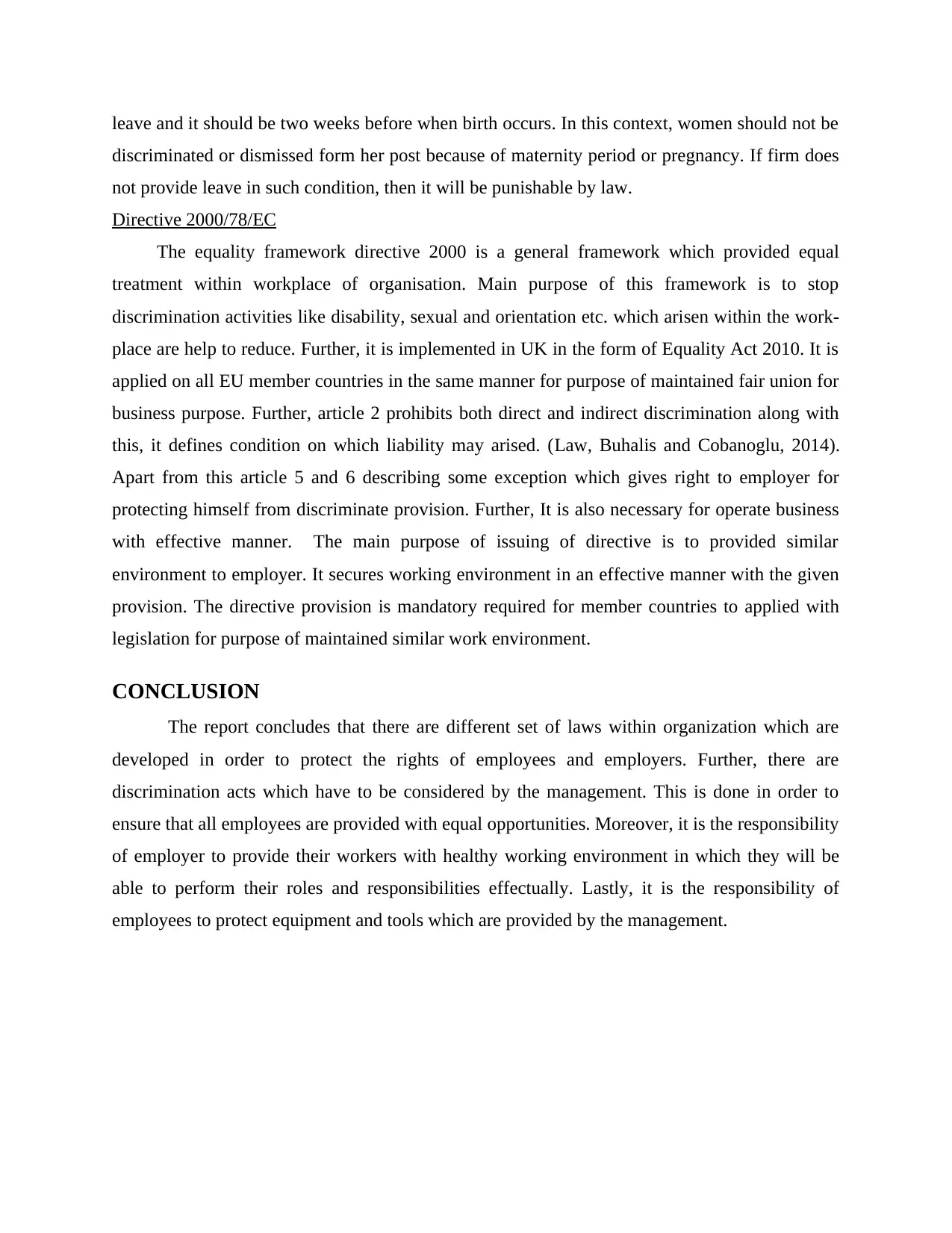
leave and it should be two weeks before when birth occurs. In this context, women should not be
discriminated or dismissed form her post because of maternity period or pregnancy. If firm does
not provide leave in such condition, then it will be punishable by law.
Directive 2000/78/EC
The equality framework directive 2000 is a general framework which provided equal
treatment within workplace of organisation. Main purpose of this framework is to stop
discrimination activities like disability, sexual and orientation etc. which arisen within the work-
place are help to reduce. Further, it is implemented in UK in the form of Equality Act 2010. It is
applied on all EU member countries in the same manner for purpose of maintained fair union for
business purpose. Further, article 2 prohibits both direct and indirect discrimination along with
this, it defines condition on which liability may arised. (Law, Buhalis and Cobanoglu, 2014).
Apart from this article 5 and 6 describing some exception which gives right to employer for
protecting himself from discriminate provision. Further, It is also necessary for operate business
with effective manner. The main purpose of issuing of directive is to provided similar
environment to employer. It secures working environment in an effective manner with the given
provision. The directive provision is mandatory required for member countries to applied with
legislation for purpose of maintained similar work environment.
CONCLUSION
The report concludes that there are different set of laws within organization which are
developed in order to protect the rights of employees and employers. Further, there are
discrimination acts which have to be considered by the management. This is done in order to
ensure that all employees are provided with equal opportunities. Moreover, it is the responsibility
of employer to provide their workers with healthy working environment in which they will be
able to perform their roles and responsibilities effectually. Lastly, it is the responsibility of
employees to protect equipment and tools which are provided by the management.
discriminated or dismissed form her post because of maternity period or pregnancy. If firm does
not provide leave in such condition, then it will be punishable by law.
Directive 2000/78/EC
The equality framework directive 2000 is a general framework which provided equal
treatment within workplace of organisation. Main purpose of this framework is to stop
discrimination activities like disability, sexual and orientation etc. which arisen within the work-
place are help to reduce. Further, it is implemented in UK in the form of Equality Act 2010. It is
applied on all EU member countries in the same manner for purpose of maintained fair union for
business purpose. Further, article 2 prohibits both direct and indirect discrimination along with
this, it defines condition on which liability may arised. (Law, Buhalis and Cobanoglu, 2014).
Apart from this article 5 and 6 describing some exception which gives right to employer for
protecting himself from discriminate provision. Further, It is also necessary for operate business
with effective manner. The main purpose of issuing of directive is to provided similar
environment to employer. It secures working environment in an effective manner with the given
provision. The directive provision is mandatory required for member countries to applied with
legislation for purpose of maintained similar work environment.
CONCLUSION
The report concludes that there are different set of laws within organization which are
developed in order to protect the rights of employees and employers. Further, there are
discrimination acts which have to be considered by the management. This is done in order to
ensure that all employees are provided with equal opportunities. Moreover, it is the responsibility
of employer to provide their workers with healthy working environment in which they will be
able to perform their roles and responsibilities effectually. Lastly, it is the responsibility of
employees to protect equipment and tools which are provided by the management.
⊘ This is a preview!⊘
Do you want full access?
Subscribe today to unlock all pages.

Trusted by 1+ million students worldwide
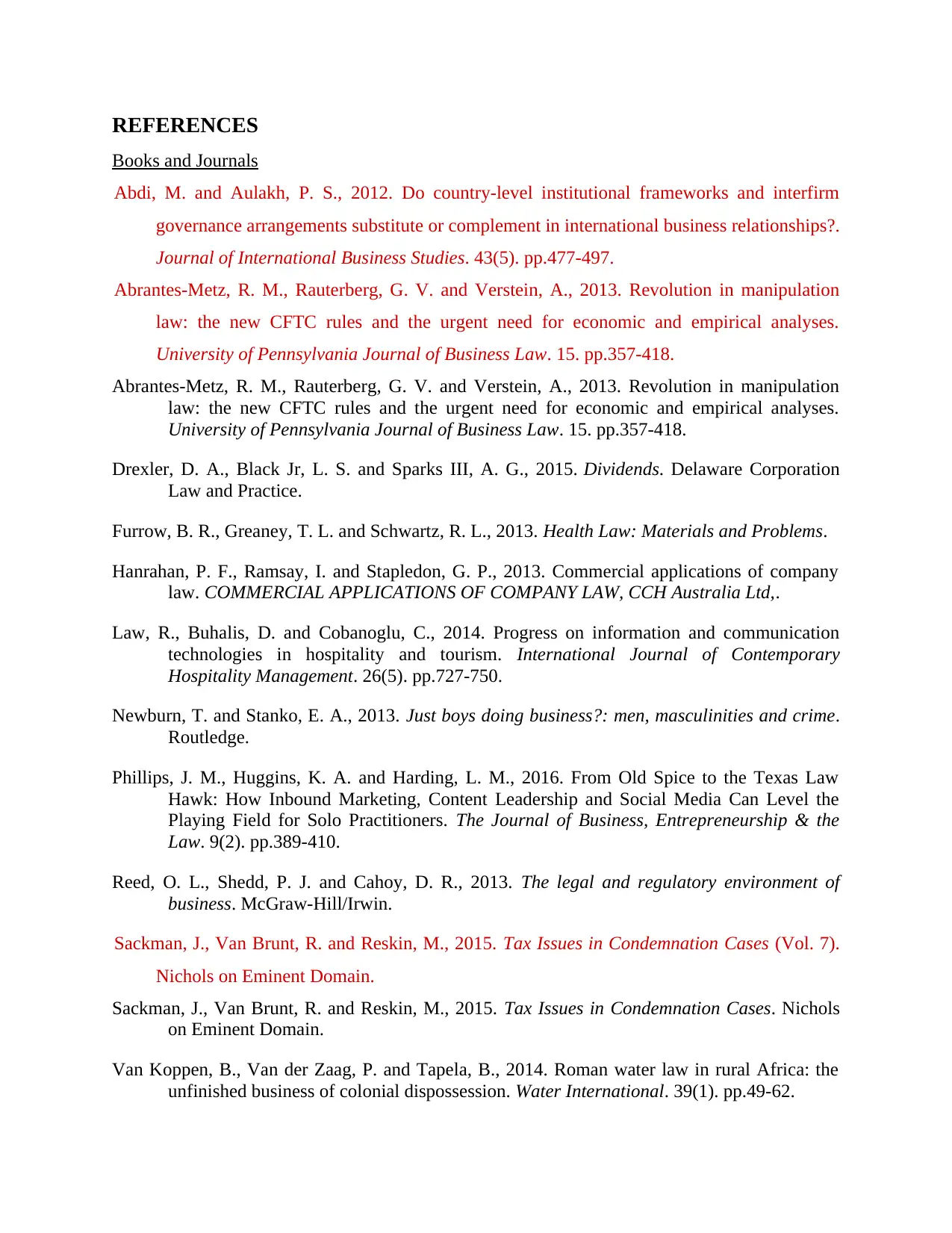
REFERENCES
Books and Journals
Abdi, M. and Aulakh, P. S., 2012. Do country-level institutional frameworks and interfirm
governance arrangements substitute or complement in international business relationships?.
Journal of International Business Studies. 43(5). pp.477-497.
Abrantes-Metz, R. M., Rauterberg, G. V. and Verstein, A., 2013. Revolution in manipulation
law: the new CFTC rules and the urgent need for economic and empirical analyses.
University of Pennsylvania Journal of Business Law. 15. pp.357-418.
Abrantes-Metz, R. M., Rauterberg, G. V. and Verstein, A., 2013. Revolution in manipulation
law: the new CFTC rules and the urgent need for economic and empirical analyses.
University of Pennsylvania Journal of Business Law. 15. pp.357-418.
Drexler, D. A., Black Jr, L. S. and Sparks III, A. G., 2015. Dividends. Delaware Corporation
Law and Practice.
Furrow, B. R., Greaney, T. L. and Schwartz, R. L., 2013. Health Law: Materials and Problems.
Hanrahan, P. F., Ramsay, I. and Stapledon, G. P., 2013. Commercial applications of company
law. COMMERCIAL APPLICATIONS OF COMPANY LAW, CCH Australia Ltd,.
Law, R., Buhalis, D. and Cobanoglu, C., 2014. Progress on information and communication
technologies in hospitality and tourism. International Journal of Contemporary
Hospitality Management. 26(5). pp.727-750.
Newburn, T. and Stanko, E. A., 2013. Just boys doing business?: men, masculinities and crime.
Routledge.
Phillips, J. M., Huggins, K. A. and Harding, L. M., 2016. From Old Spice to the Texas Law
Hawk: How Inbound Marketing, Content Leadership and Social Media Can Level the
Playing Field for Solo Practitioners. The Journal of Business, Entrepreneurship & the
Law. 9(2). pp.389-410.
Reed, O. L., Shedd, P. J. and Cahoy, D. R., 2013. The legal and regulatory environment of
business. McGraw-Hill/Irwin.
Sackman, J., Van Brunt, R. and Reskin, M., 2015. Tax Issues in Condemnation Cases (Vol. 7).
Nichols on Eminent Domain.
Sackman, J., Van Brunt, R. and Reskin, M., 2015. Tax Issues in Condemnation Cases. Nichols
on Eminent Domain.
Van Koppen, B., Van der Zaag, P. and Tapela, B., 2014. Roman water law in rural Africa: the
unfinished business of colonial dispossession. Water International. 39(1). pp.49-62.
Books and Journals
Abdi, M. and Aulakh, P. S., 2012. Do country-level institutional frameworks and interfirm
governance arrangements substitute or complement in international business relationships?.
Journal of International Business Studies. 43(5). pp.477-497.
Abrantes-Metz, R. M., Rauterberg, G. V. and Verstein, A., 2013. Revolution in manipulation
law: the new CFTC rules and the urgent need for economic and empirical analyses.
University of Pennsylvania Journal of Business Law. 15. pp.357-418.
Abrantes-Metz, R. M., Rauterberg, G. V. and Verstein, A., 2013. Revolution in manipulation
law: the new CFTC rules and the urgent need for economic and empirical analyses.
University of Pennsylvania Journal of Business Law. 15. pp.357-418.
Drexler, D. A., Black Jr, L. S. and Sparks III, A. G., 2015. Dividends. Delaware Corporation
Law and Practice.
Furrow, B. R., Greaney, T. L. and Schwartz, R. L., 2013. Health Law: Materials and Problems.
Hanrahan, P. F., Ramsay, I. and Stapledon, G. P., 2013. Commercial applications of company
law. COMMERCIAL APPLICATIONS OF COMPANY LAW, CCH Australia Ltd,.
Law, R., Buhalis, D. and Cobanoglu, C., 2014. Progress on information and communication
technologies in hospitality and tourism. International Journal of Contemporary
Hospitality Management. 26(5). pp.727-750.
Newburn, T. and Stanko, E. A., 2013. Just boys doing business?: men, masculinities and crime.
Routledge.
Phillips, J. M., Huggins, K. A. and Harding, L. M., 2016. From Old Spice to the Texas Law
Hawk: How Inbound Marketing, Content Leadership and Social Media Can Level the
Playing Field for Solo Practitioners. The Journal of Business, Entrepreneurship & the
Law. 9(2). pp.389-410.
Reed, O. L., Shedd, P. J. and Cahoy, D. R., 2013. The legal and regulatory environment of
business. McGraw-Hill/Irwin.
Sackman, J., Van Brunt, R. and Reskin, M., 2015. Tax Issues in Condemnation Cases (Vol. 7).
Nichols on Eminent Domain.
Sackman, J., Van Brunt, R. and Reskin, M., 2015. Tax Issues in Condemnation Cases. Nichols
on Eminent Domain.
Van Koppen, B., Van der Zaag, P. and Tapela, B., 2014. Roman water law in rural Africa: the
unfinished business of colonial dispossession. Water International. 39(1). pp.49-62.
1 out of 10
Related Documents
Your All-in-One AI-Powered Toolkit for Academic Success.
+13062052269
info@desklib.com
Available 24*7 on WhatsApp / Email
![[object Object]](/_next/static/media/star-bottom.7253800d.svg)
Unlock your academic potential
Copyright © 2020–2025 A2Z Services. All Rights Reserved. Developed and managed by ZUCOL.





